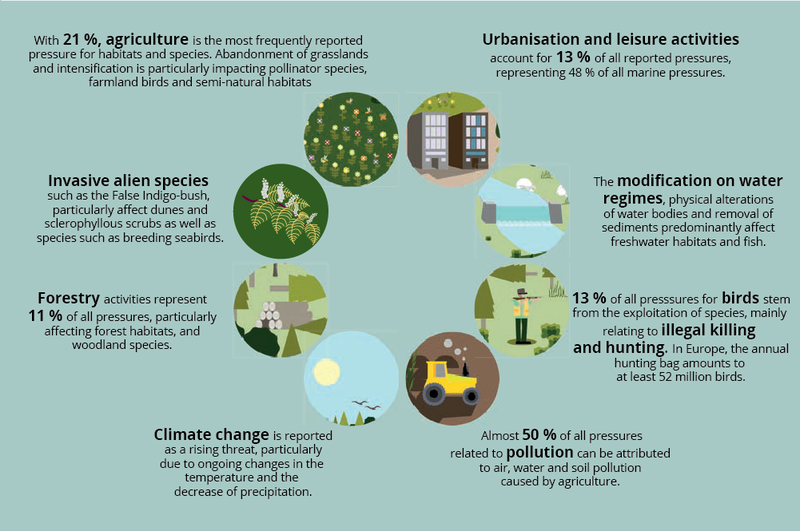All official European Union website addresses are in the europa.eu domain.
See all EU institutions and bodiesEurope’s nature is experiencing a serious and continuing decline. The challenge to protect it is urgent, and significant additional efforts are needed to reverse the current trend.
The health of Europe’s nature is at risk. Many species, habitats and ecosystems in Europe — all vital to our well-being — are threatened by urban sprawl, unsustainable farming and forestry, and pollution. Our latest assessment shows that Europe’s biodiversity continues to decline at an alarming rate, with most protected species and habitats found not to have a good conservation status. Greater effort is needed to reverse current trends and to ensure resilient and healthy nature.
Europe has set itself ambitious goals to protect, preserve and restore nature. Effective action for healthy nature can help tackle climate change and build resilient societies and economies.
According to the latest EEA report on the ‘State of nature in the EU’, more effective implementation of environmental legislation (including the EU Habitats and Birds Directives) and a transition to sustainable practices in socio-economic sectors are needed to lessen the severe impact on Europe’s nature. The EEA report is published simultaneously with the European Commission’s State of Nature report to the European Council and Parliament, informing about the progress made in reaching the aims of the EU’s nature legislation.
Key findings from the latest State of Nature report:
- Climate change is a rising threat, especially because of increased drought and lower precipitation.
- Agricultural activities, land abandonment and urbanisation are the major pressures on habitats and species, followed by pollution.
- The conservation status of only 14% of habitats assessments and 27% of non-bird species is ‘good’. Pollinators’ habitats have worse conservation status and trends than other habitats.
- The population status of almost half of the bird species in the Birds Directive is ‘good’; however, the lowest number of improving trends is that for farmland birds.
- Natura 2000 sites cover 18% of land and 10% of marine waters in the EU.
Read the whole assessment on the state of nature
Our assessment shows that safeguarding the health and resilience of Europe’s nature, and people’s well-being, requires fundamental changes to the way we produce and consume food, manage and use forests, and build cities. These efforts need to be coupled with better implementation and enforcement of conservation policies, a focus on nature restoration, as well as increasingly ambitious climate action, especially in the transport and energy sector.
Hans Bruyninckx, EEA Executive Director
What causes biodiversity loss?
Depending on the habitat, region or species, the pressures on biodiversity may vary. Our assessments show that many agricultural activities and intensifying management practices or the abandonment of extensive management are the most common overall pressures. Urbanisation is the second largest pressure and it particularly affects habitats such as dunes and coastal and rocky habitats. Forestry activities are the main source of pressure on species (e.g. arthropods, mammals and non-vascular plants). The pollution of air, water and soil, particularly from but not limited to agriculture, affects most habitats, particularly in the European Union’s Atlantic and continental regions.

Background information: How do we monitor the state of nature?
To understand the changes in Europe’s biodiversity over time, the European Union relies on data collected and reported in a consistent and comparable way. Every six years, EU Member States are required to report on the sizes of and trends in bird populations (Article 12 of the Birds Directive) and on the conservation status of and trends in targeted habitats and species (Article 17 of the Habitats Directive) within their European territories.
The reporting under the Birds Directive covers all species of naturally occurring wild birds in Europe (over 460), while reporting under the Habitats Directive only covers a selection of habitats (233) and species (1,389) that are considered characteristic of Europe, or are rare and/or endangered.
The EEA’s contribution
The EEA supports the European Commission in collecting and reviewing the data submitted by EU Member States. Such data are subsequently used to assess the health of Europe’s nature. This assessment provides vital knowledge. It not only evaluates how EU nature legislation has fared in meeting its biodiversity objectives but it also provides good-quality data to inform future decisions in relation to EU nature policy and legislation.
In addition, the EEA hosts the European Biodiversity Data Centre, the Biodiversity Information System for Europe (BISE) and the European Nature Information System (EUNIS), providing information on protected areas, habitat types and species. The EUNIS habitat classification provides harmonised names and descriptions of European natural habitats, which are important for countries’ joint efforts on biodiversity and reporting. Such tools contribute to the knowledge base for implementing EU and global biodiversity strategies and the Seventh Environmental Action Programme.
